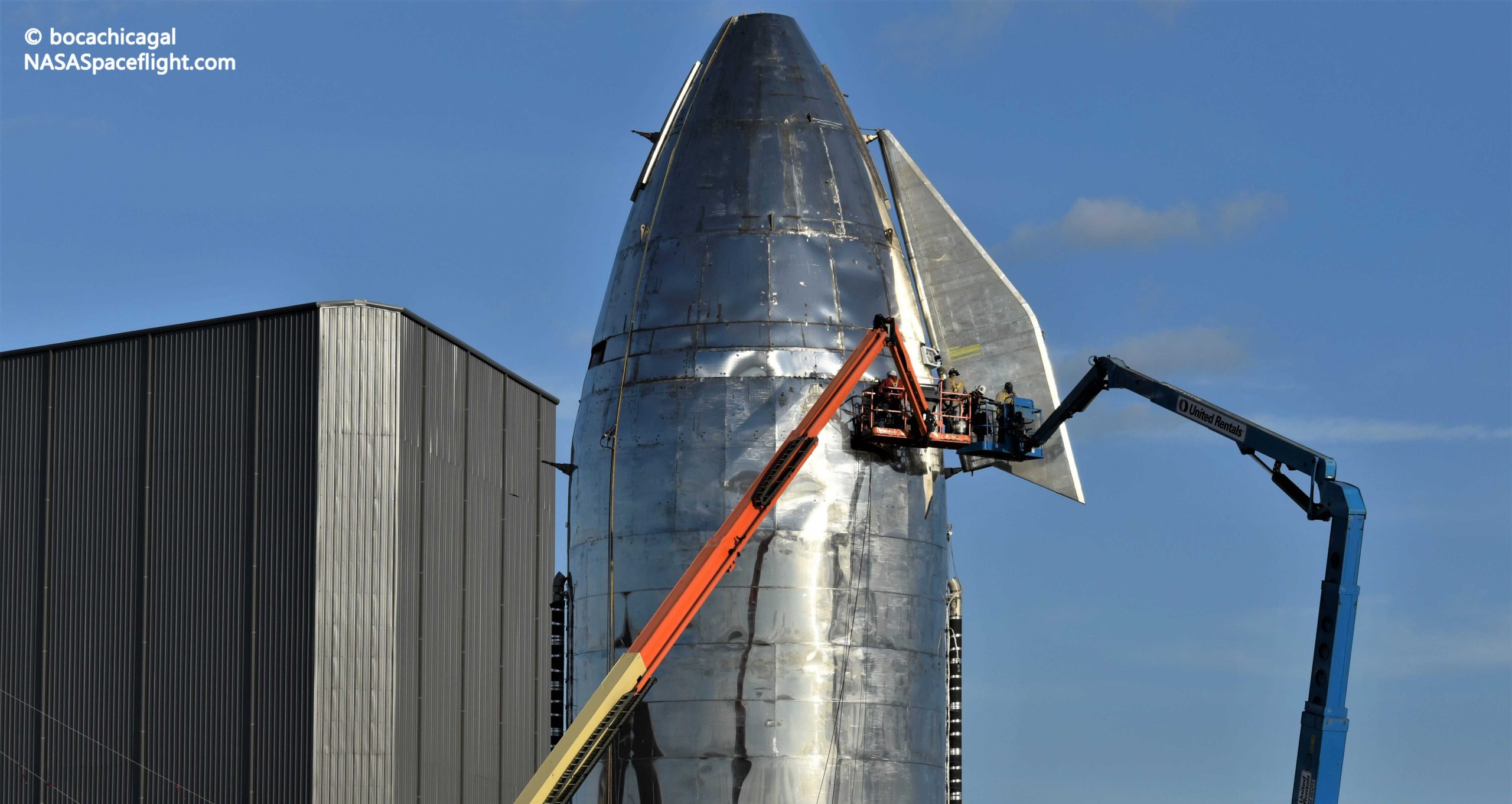
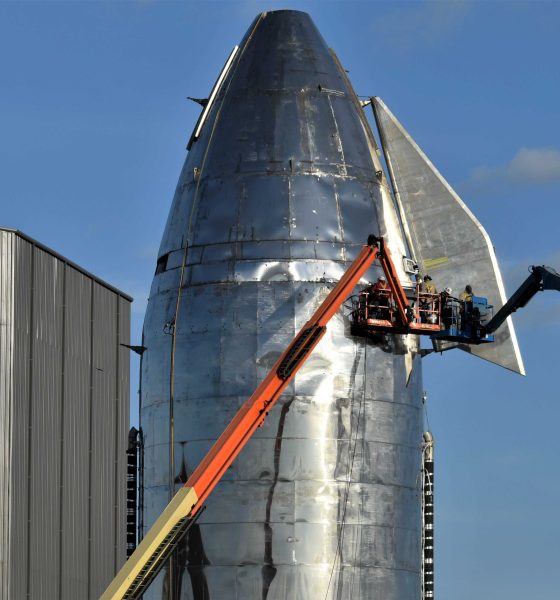
News
SpaceX installs Starship Mk1 rocket’s flaps for the second time in build-up to flight debut
A little over a month after SpaceX CEO Elon Musk presented an update on Starship in Boca Chica, Texas and technicians dressed the rocket up for the show, SpaceX has begun to install Starship Mk1’s flaps for the second time.
This time, with any luck, those flaps are here to stay until Starship Mk1’s inaugural launch debut, an ambitious flight test with a target altitude of 20 km (12 mi).
Around the second half of September, SpaceX technicians appeared to begin working around the clock to fully assemble Starship, outfitting the exterior with the beginnings of plumbing, power lines, and avionics harnesses, stacking the Mk1 prototype’s two halves, and installing the vehicle’s large fore and aft flaps. During SpaceX CEO Elon Musk’s September 28th Starship update, what looked to be the largely finished Starship Mk1 served as the main backdrop – an undeniably impressive one, at that.

As would soon become clear, SpaceX’s September 2019 Starship Mk1 integration was actually more of a mock-assembly – all the parts involved appear to genuinely be real flight hardware, but almost all of it was only temporarily attached to Starship to give the partial appearance of a finished ship. By October 1st, technicians began removing Starship Mk1’s four flaps, flap shrouds, and leg shrouds, finally culminating in the separation of the rocket prototype’s upper and lower halves.
The fact that neither Musk or SpaceX spokespersons noted that Starship wasn’t actually complete is at least a little unsavory, although it’s admittedly unsurprising given CEO Elon Musk’s known affinity for grand gestures and events. On a positive note, Starship’s mock-assembly likely served as an excellent learning experience for the Boca Chica team and thankfully only seems to have caused a week or two of delay.
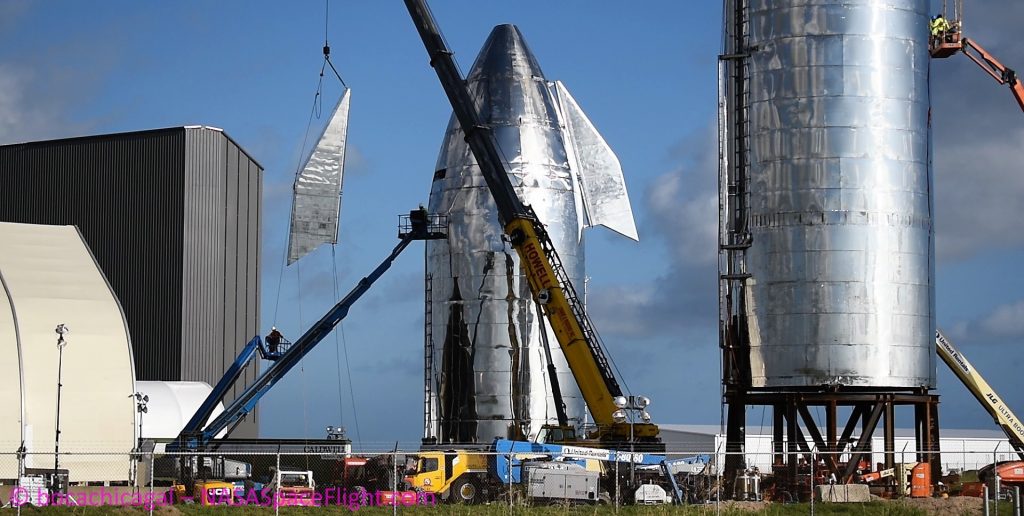
Rapid progress in Boca Chica
Despite the mild disruption of dressing Starship Mk1 up for Musk’s presentation, SpaceX Boca Chica has made a huge amount of progress in the five weeks since. Barely three weeks after the rocket’s forward flaps (canards) were removed, SpaceX technicians began the reinstallation process with one major visible difference: a massive motorcycle-sized actuator.
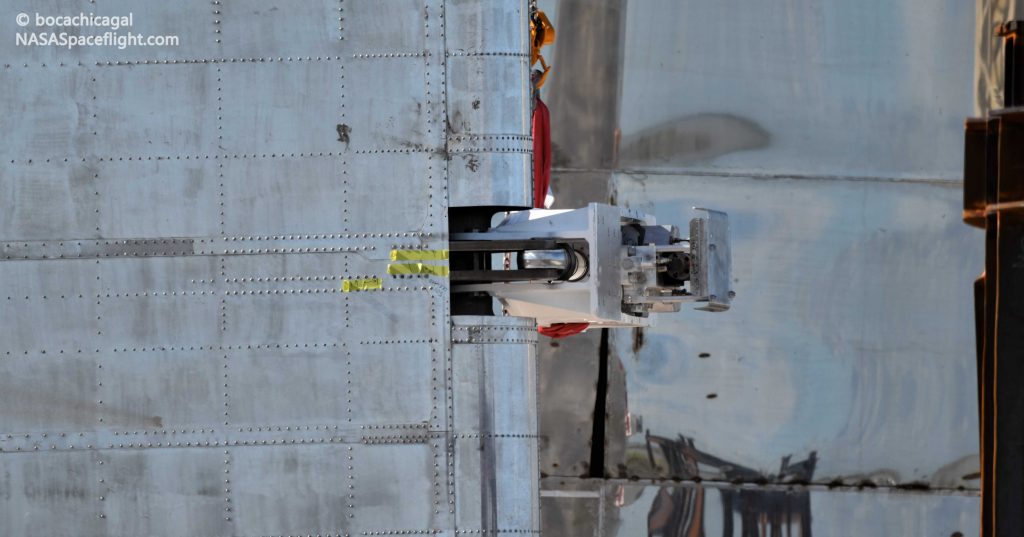
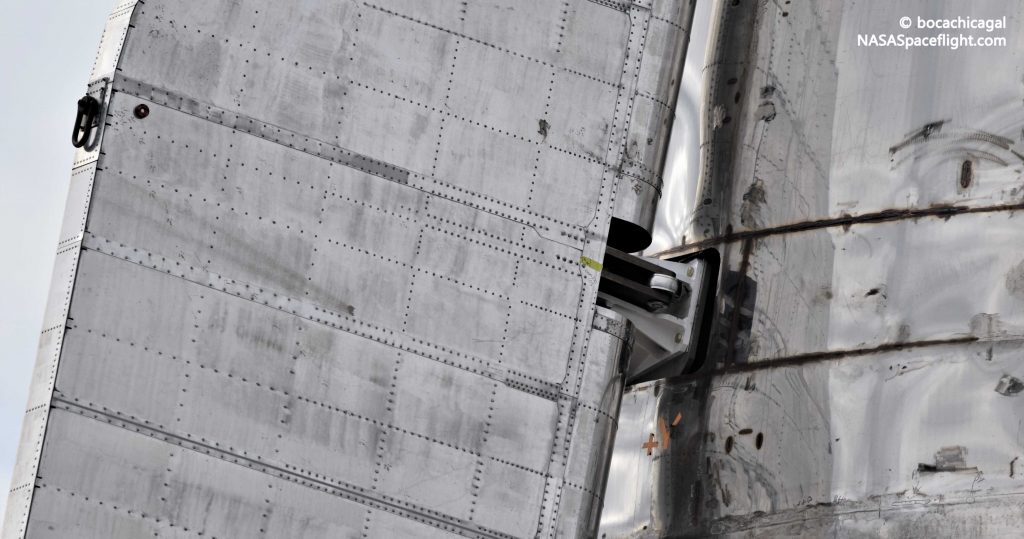
On the first round of installations-for-show, Starship Mk1’s flaps featured no such mechanism, confirming suspicions that much of the hardware installed at the last second was not quite finished or was only being installed for Musk (and practice). The appearance of a previously unseen actuator mechanism on the first reinstalled canard suggests that this time around, SpaceX is installing Starship’s flaps with their final purpose of controlling Starship’s free-fall in mind.
Instead of copying Falcon 9’s proven method of vertical launch and vertical landing, SpaceX is taking a more radical approach with Starship that will see the spacecraft reenter Earth’s atmosphere belly-first, slow its forward speed to near-zero, and fall directly down for approximately 25 km (15.5 mi), using its flaps like a skydiver’s limbs. Perhaps just a few hundred meters above the ground, Starship will finally perform an aggressive flip maneuver, igniting its Raptors while sideways, swerving to neutralize that horizontal velocity, and finally landing on six small legs.
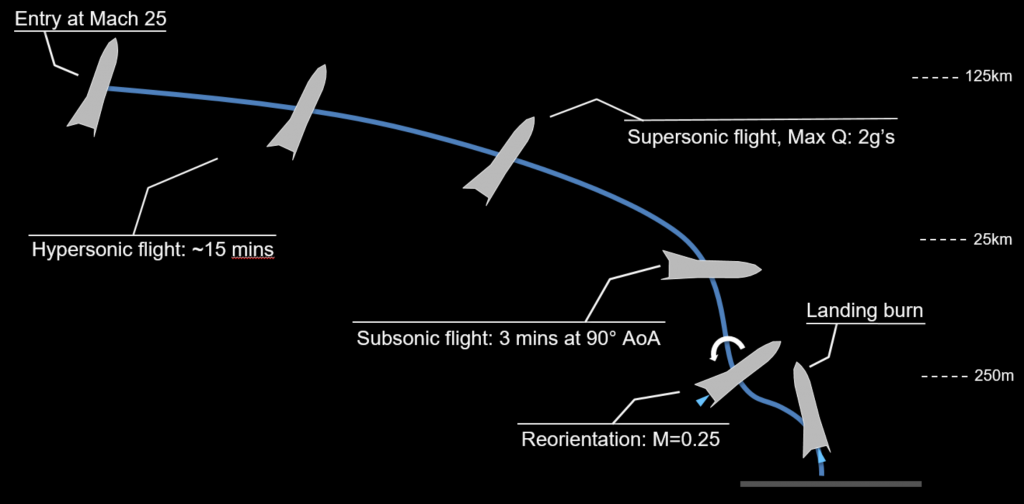
In this sense, although they certainly look the part, Starship’s aerodynamic control surfaces are very explicitly not wings and are instead meant to interact with the atmosphere at an almost 90-degree angle of attack (AoA). In line with that strategy, they only have to actuate with a single degree of freedom, drastically simplifying Starship’s control surfaces.
Similar to Starship Mk1’s newly filled-out canard actuators, SpaceX technicians have installed two massive hinges/mounts for Starship’s larger after flaps. Aft flap installation will likely start as soon as SpaceX technicians have installed the bulk of Starship Mk1’s external plumbing and wiring, a milestone that appears to be fast approaching.
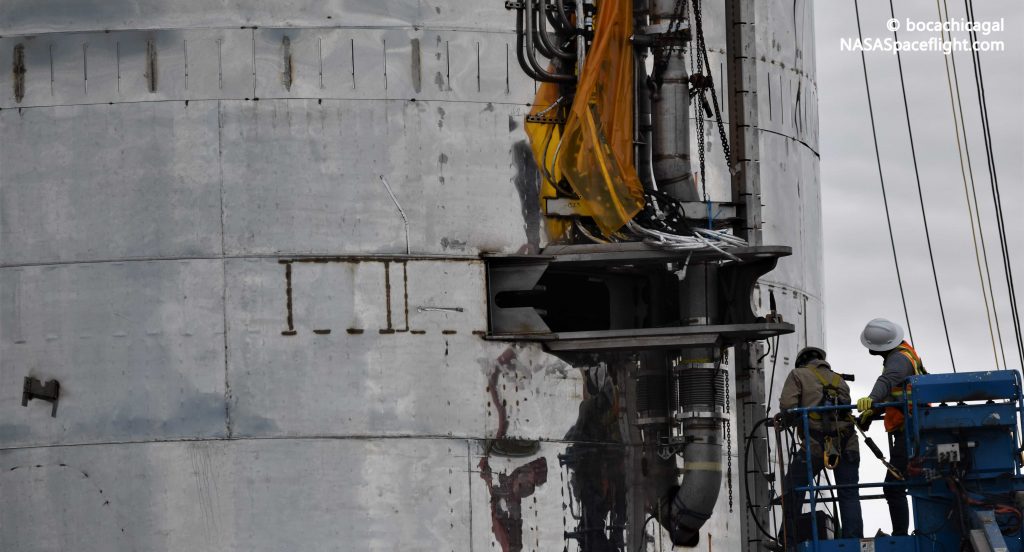
Starship Mk1’s lower half was unexpectedly moved about a mile to SpaceX’s nearby launch facilities prior to the installation of its nose section, meaning that SpaceX will likely have to transport the nose to the launch pad for final mating. It’s unclear what tests SpaceX specifically plans to kick off Starship Mk1’s pre-flight preparations with, but it’s safe to assume that the most imminent milestone is a wet dress rehearsal (WDR), possibly preceded by a tank proof test.
The latter procedure would be designed to prove that Starship Mk1’s pressure vessel is both leakproof and structurally sound and would nominally involve filling the spacecraft’s tanks with a neutral fluid (likely water or liquid nitrogen). A WDR would see SpaceX load Starship as if preparing for launch (requiring liquid oxygen, methane, nitrogen, and helium) but stopping just prior to the engine ignition and liftoff that would otherwise follow. Although unlikely, a WDR could result in a massive fire or explosion if Starship were to lose structural integrity during the test, which is why the aforementioned neutral testing is typically performed first when handling brand new launch vehicles.
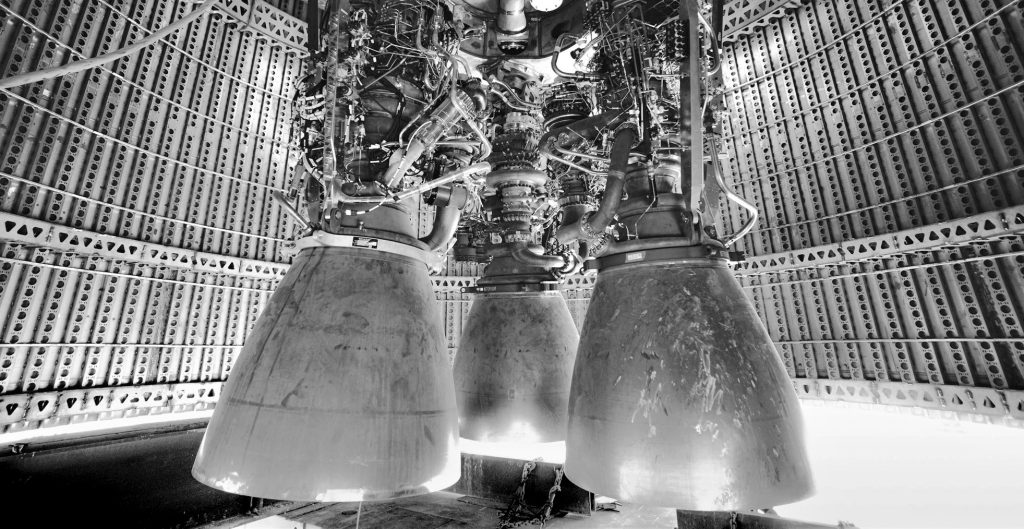
Finally, assuming Starship Mk1 successfully passes the above tests, SpaceX will use the vehicle to perform Raptor’s first triple-engine static fire test. That static fire will likely be the final major test activity before SpaceX readies Starship Mk1 for its 20-km flight debut, which will serve as a more or less full-fidelity test of Starship’s exotic skydiver-like landing.
Regardless of how exactly Starship Mk1’s imminent test campaign will play out, SpaceX has road closures scheduled on November 7th, 8th, and 12th. Right now, it’s anyone’s guess what is planned for Thursday and Friday, but it could potentially involve a tank proof test, launch pad checkouts, propellant loading, or something more benign, like transporting Starship’s nose section to the pad for final installation. Stay tuned!
Check out Teslarati’s Marketplace! We offer Tesla accessories, including for the Tesla Cybertruck and Tesla Model 3.

News
Tesla Model Y Standard Long Range RWD launches in Europe
The update was announced by Tesla Europe & Middle East in a post on its official social media account on X.

Tesla has expanded the Model Y lineup in Europe with the introduction of the Standard Long Range RWD variant, which offers an impressive 657 km of WLTP range.
The update was announced by Tesla Europe & Middle East in a post on its official social media account on X.
Model Y Standard Long Range RWD Details
Tesla Europe & Middle East highlighted some of the Model Y Standard Long Range RWD’s most notable specs, from its 657 km of WLTP range to its 2,118 liters of cargo volume. More importantly, Tesla also noted that the newly released variant only consumes 12.7 kWh per 100 km, making it the most efficient Model Y to date.
The Model Y Standard provides a lower entry point for consumers who wish to enter the Tesla ecosystem at the lowest possible price. While the Model 3 Standard is still more affordable, some consumers might prefer the Model Y Standard due to its larger size and crossover form factor. The fact that the Model Y Standard is equipped with Tesla’s AI4 computer also makes it ready for FSD’s eventual rollout to the region.
Top Gear’s Model Y Standard review
Top Gear‘s recent review of the Tesla Model Y Standard highlighted some of the vehicle’s most notable features, such as its impressive real-world range, stellar infotainment system, and spacious interior. As per the publication, the Model Y Standard still retains a lot of what makes Tesla’s vehicles well-rounded, even if it’s been equipped with a simplified interior.
Top Gear compared the Model Y Standard to its rivals in the same segment. “The introduction of the Standard trim brings the Model Y in line with the entry price of most of its closest competition. In fact, it’s actually cheaper than a Peugeot e-3008 and costs £5k less than an entry-level Audi Q4 e-tron. It also makes the Ford Mustang Mach-E look a little short with its higher entry price and worse range,” the publication wrote.
Elon Musk
Elon Musk’s xAI bets $20B on Mississippi with 2GW AI data center project
The project is expected to create hundreds of permanent jobs, dramatically expand xAI’s computing capacity, and further cement the Mid-South as a growing hub for AI infrastructure.

Elon Musk’s xAI plans to pour more than $20 billion into a massive new data center campus in Southaven, Mississippi, marking the largest single economic development project in the state’s history.
The project is expected to create hundreds of permanent jobs, dramatically expand xAI’s computing capacity, and further cement the Mid-South as a growing hub for AI infrastructure.
xAI goes MACROHARDRR in Mississippi
xAI has acquired and is retrofitting an existing facility in Southaven to serve as a new data center, which will be known as “MACROHARDRR.” The site sits near a recently acquired power plant and close to one of xAI’s existing data centers in Tennessee, creating a regional cluster designed to support large-scale AI training and inference.
Once completed, the Southaven facility is expected to push the company’s total computing capacity to nearly 2 GW, placing it among the most powerful AI compute installations globally. The data center is scheduled to begin operations in February 2026.
Gov. Tate Reeves shared his optimism about the project in a press release. “This record-shattering $20 billion investment is an amazing start to what is sure to be another incredible year for economic development in Mississippi. Today, Elon Musk is bringing xAI to DeSoto County, a project that will transform the region and bring amazing opportunities to its residents for generations. This is the largest economic development project in Mississippi’s history,” he said.
xAI’s broader AI ambitions
To secure the investment, the Mississippi Development Authority approved xAI for its Data Center Incentive program, which provides sales and use tax exemptions on eligible computing hardware and software. The City of Southaven and DeSoto County are also supporting the project through fee-in-lieu agreements aimed at accelerating development timelines and reducing upfront costs.
Founded in 2023 by Elon Musk, xAI develops advanced artificial intelligence systems focused on large-scale reasoning and generative applications. Its flagship product, Grok, is integrated with the social media platform X, alongside a growing suite of APIs for image generation, voice, and autonomous agents, including offerings tailored for government use.
Elon Musk highlighted xAi’s growth and momentum in a comment about the matter. “xAI is scaling at an immeasurable pace — we are building our third massive data center in the greater Memphis area. MACROHARDRR pushes our Colossus training compute to ~2GW – by far the most powerful AI system on Earth. This is insane execution speed by xAI and the state of Mississippi. We are grateful to Governor Reeves for his support of building xAI at warp speed,” Musk said.
Elon Musk
Tesla AI Head says future FSD feature has already partially shipped

Tesla’s Head of AI, Ashok Elluswamy, says that something that was expected with version 14.3 of the company’s Full Self-Driving platform has already partially shipped with the current build of version 14.2.
Tesla and CEO Elon Musk have teased on several occasions that reasoning will be a big piece of future Full Self-Driving builds, helping bring forth the “sentient” narrative that the company has pushed for these more advanced FSD versions.
Back in October on the Q3 Earnings Call, Musk said:
“With reasoning, it’s literally going to think about which parking spot to pick. It’ll drop you off at the entrance of the store, then go find a parking spot. It’s going to spot empty spots much better than a human. It’s going to use reasoning to solve things.”
Musk said in the same month:
“By v14.3, your car will feel like it is sentient.”
Amazingly, Tesla Full Self-Driving v14.2.2.2, which is the most recent iteration released, is very close to this sentient feeling. However, there are more things that need to be improved, and logic appears to be in the future plans to help with decision-making in general, alongside other refinements and features.
On Thursday evening, Elluswamy revealed that some of the reasoning features have already been rolled out, confirming that it has been added to navigation route changes during construction, as well as with parking options.
He added that “more and more reasoning will ship in Q1.”
🚨 Tesla’s Ashok Elluswamy reveals Nav decisions when encountering construction and parking options contain “some elements of reasoning”
More uses of reasoning will be shipped later this quarter, a big tidbit of info as we wait v14.3 https://t.co/jty8llgsKM
— TESLARATI (@Teslarati) January 9, 2026
Interestingly, parking improvements were hinted at being added in the initial rollout of v14.2 several months ago. These had not rolled out to vehicles quite yet, as they were listed under the future improvements portion of the release notes, but it appears things have already started to make their way to cars in a limited fashion.
Tesla Full Self-Driving v14.2 – Full Review, the Good and the Bad
As reasoning is more involved in more of the Full Self-Driving suite, it is likely we will see cars make better decisions in terms of routing and navigation, which is a big complaint of many owners (including me).
Additionally, the operation as a whole should be smoother and more comfortable to owners, which is hard to believe considering how good it is already. Nevertheless, there are absolutely improvements that need to be made before Tesla can introduce completely unsupervised FSD.








